“OK, my plan for the turn: cyclotron to face this way, omnistomp, kill this guy, hexmatic, then speed along, and tow the bomb with me.”
“Yes, so the issue is that I’m the first player.”
“And?”
“And I’m going to push you. Ever so gently. Slightly messing up all your plans.”
“Noooo!”
“Yes, it’s going to happen. Ssshhh, just let it happen.”
(true story!)
Mechs vs. Minions is the first and only board game published by Riot Games, the company behind the small indie video game called League of Legends. They must be doing something right, they have one super successful video game (not for long, because more are coming in 2020, so they will have multiple super successful video games) and one super successful board game. I do have my own long love and hate relationship with LoL, so I can’t really see MvM without that angle, please bear that in mind. Riot Games took a quite surprising and honestly admirable route, the characters and the world are very well embedded in the world of Runeterra, but the gameplay is not even close.
The story is childish and cartoony, the 2 – 4 of you start your journey when you enlist in this so-called mech school and run into all sorts of shenanigans. Your adventures unfold in the structure of a campaign, with 10 consecutive scenarios. Every scenario starts with you opening a special envelope with some new stuff, so the game is kinda legacy, but you can always just pack all the envelopes back. There is also one very secretive sealed box with “Danger!!!” written all over it. You can immediately see an axe cutting through the box, I’m not gonna spoil what is inside, but it’s quite cool.
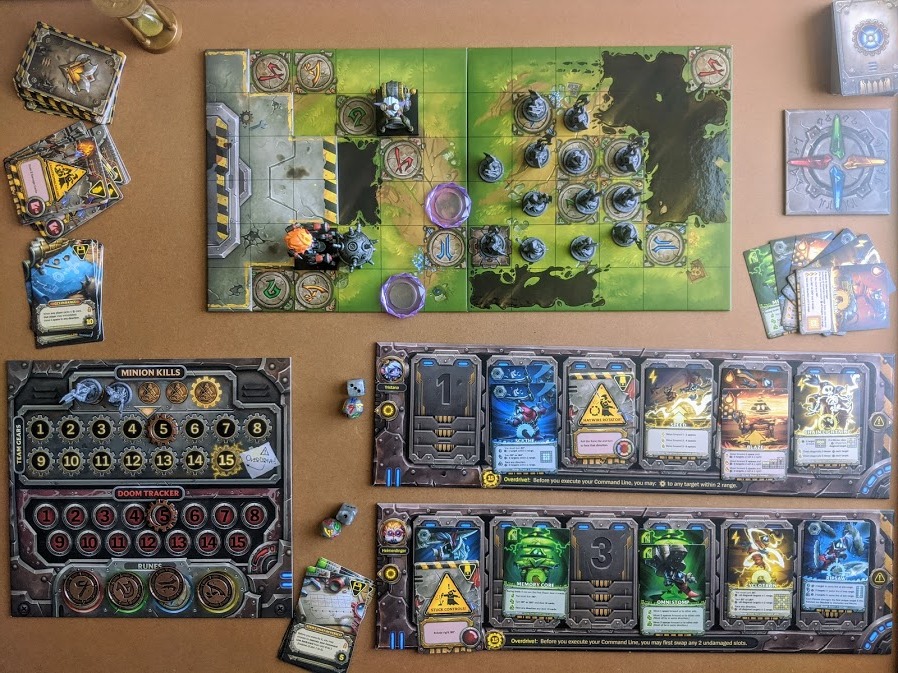
Scenarios come with their own tweaks of rules. Minions (your eternal enemies!) might move differently, crystal shards might be important, or there may or may not be a huge lava wall, etc.
And then within the individual scenarios is the most interesting and brilliant part of the game, the micro-level. Each player interacts with their mech via a control panel. You start each scenario with an empty panel, and then through card-drafting, you build up cards in your control panel slots, numbered from 1 to 6. This is the so-called programming aspect of the game. And then comes the cool part: when it’s your turn to move, your mech will automatically do whatever is programmed in the control panel, in a strict order.
There are three types of commands you can get: turning 90/180/360 degrees (the ability to choose not to turn should not be underestimated!) moving in a straight line, or causing damage in map tiles that are in a certain range from you. There are four elements, and they all have their own versions of the three different command types. For example, the fire card attack is a flamethrower, so it damages in front of your mech in a cone, the tech card is a precision shot that can be used to target behind you, the steel card version is a long-range snipe, and the electricity is a chain lightning. Turning and moving also have their own variations. So there are 3 * 4 = 12 types of cards in total, and that’s it!
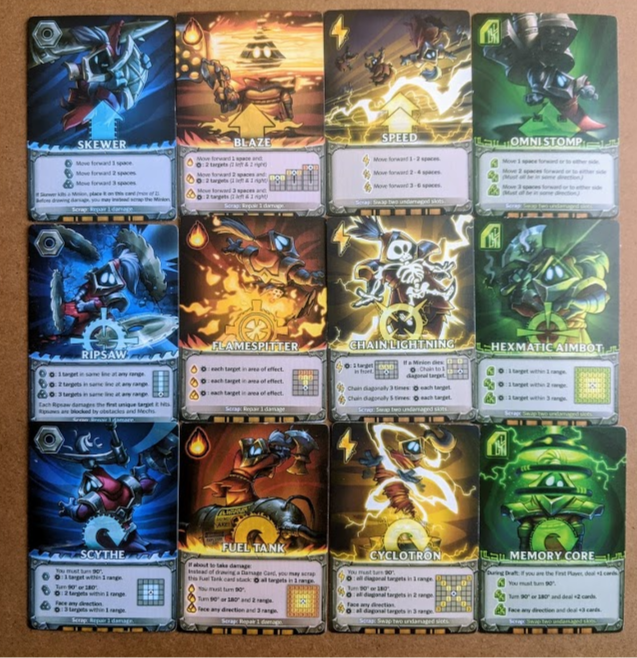
The game really revolves around this command bar, and what a wonderfully tight and well-designed idea it is! Every time you get a damage, you don’t lose health points, oh no, the game is far more sinister, instead, you draw a damage card, which you potentially have to slot in a random place in your command bar. This results in an endless variation of funny cascading messing up of your and your teammates carefully made plans.
The Good
The basic gameplay loop of Mechs vs. Minions is incredibly tight. I’m talking Pandemic-level of tightness. You have 12 types of cards, you can combine them on a 1 to 6 slot bar, and that’s it. It is really simple, and yet full of strategies. I absolutely love how this is one super well-designed core game and that’s it, there are no expansions that add fake improvements like 10 more cards or one new character to the game. It has a perfectly balanced system, and it would be a shame if anything happened to it. (Season 2 would be nice though…)
The programming part makes you feel smart, you can’t just come up with a cool plan from the get-go, you have to constantly adapt to the new cards that you draw. I haven’t mentioned it before, but as you stack cards of the same element on top of each other in your command panel, they become more powerful. And they don’t have to be the same command type. So on your first turn you might put a fire attack in command slot 3, and then on the next turn, a fire turn comes up, you realise that’s the better option for your current turn, so you insert it on top of the previous fire card to command slot 3, and now you have a level 2 fire turn card there. Of course, all the minion attacks, the environmental danger, and, sadly, your own teammates will keep screwing up your plans anyway!
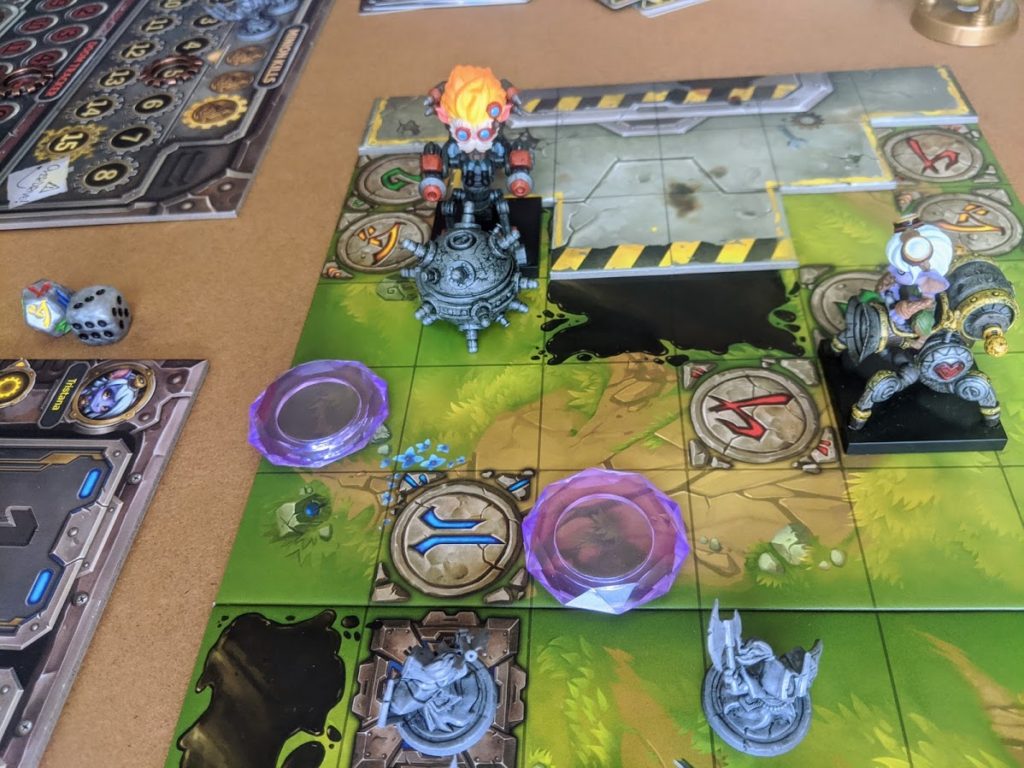
The scenarios are pretty well balanced for two players, they can be slightly on the easier side. There are generally very few rule changes, there might be different game parts that may or may not be there, crystals might have different rules, etc. But the complexity never increases to an intolerable level. You know these games, we occasionally love them too, like Spirit Island, and they are great, but the greatness comes with a price of constantly keeping track of five different rule alterations coming from different cards and tokens and abilities scattered all over the gaming area? Mechs vs. Minions is kinda the opposite of that. I think the only fiddly part to keep track of is whether you have already moved a specific minion in the round or not, but that’s it.
The production quality is super high, everything is very well made, great miniatures, the mechs even come pre-painted (sure, base colours only, but they really pop on the table), you have your crystals, metal coins, a minute glass, it really looks fantastic. All the cardboard is thick and shiny, and chrome, the box is meaty, there is no better word for it. There are like a hundred little minion enemies, they are sturdy and functional. I really am against waste and unnecessarily overproduced games, and I really praise Gloomhaven for using cardboard cutouts for its enemies, but I don’t think cardboard would have worked in this case. You want that chunkiness, that weight. Usually, we don’t mention the price, boardgames cost almost the same anyway, but this game feels very cheap, compared to its production value.
And, this is a personal favourite of mine: the game comes with The Best Insert System Ever. It’s a joy to unpack and pack this game. If you are into that sort of thing, that is.
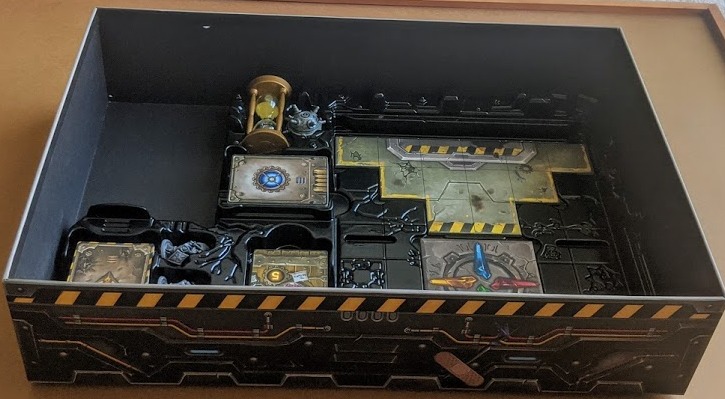
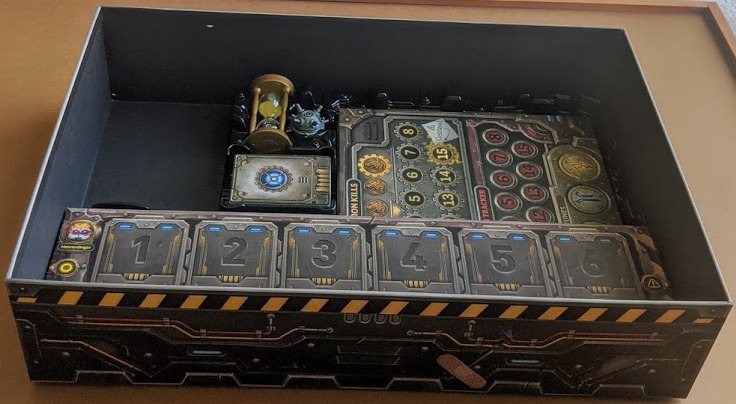
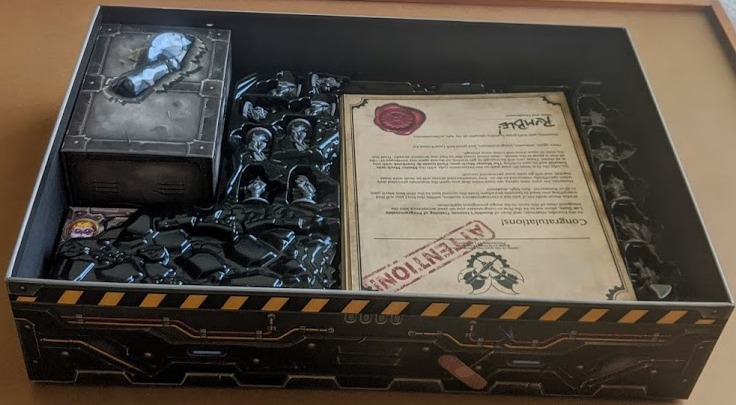
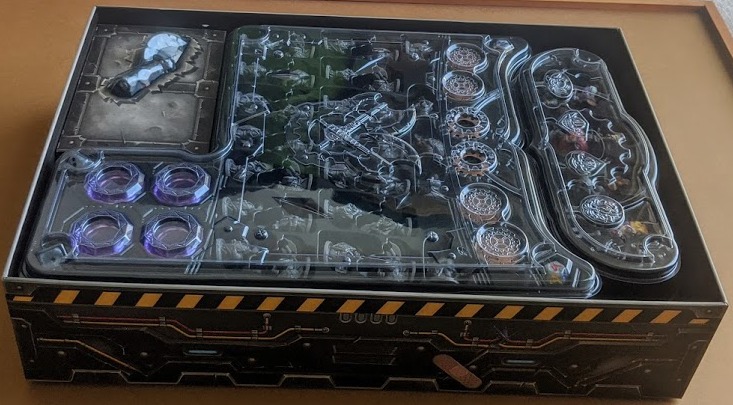
Each envelope contains a scenario book, they are richly illustrated, pleasant to look at, full of dialogues and little handwritten thingies that breathe life into the game world. For example, the four mechs (OK, let’s do this, they are Tristana, Heimerdinger, Ziggs, and Corki) have different special abilities (do one special move, rearrange your command slot, that sort of thing), and each of these cards has their schematic plan of that ability, and there are two very cool things about them: 1) they make sense, they are not just a random blueprint type drawing, they really do visually describe the ability in question, 2) their style is unique to the character, one is just a crazy doodle, the other is more methodical and mad professor-like, the third is girly, etc. Oh, and these special abilities are highly thematic and consistent with the video game.
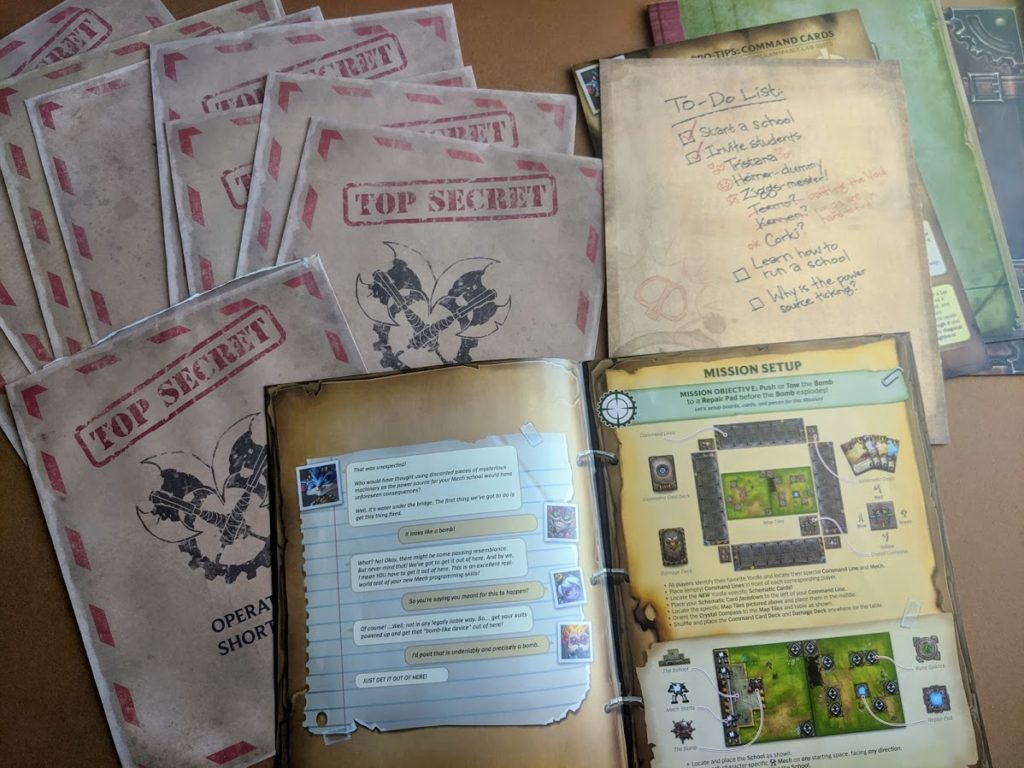
And, perhaps most importantly: the game is loads of fun! All that randomness, the goofy setting makes it an outstandingly pleasant experience. It is quite fast-paced, a scenario might take only an hour with two seasoned players. I especially love how the draft is timed, making sure there is less analysis paralysis around the table.
The Bad
Well, where shall I start? We do not like scenario 8, it’s virtually unbeatable with four players, and if you easily beat it, you are missing some rules. And there are one or two other scenarios that are not very well designed, there is one where you just have to run in a straight line, and they really stick out from the generally well-designed levels with intricate winning conditions.
The game scaling is very odd, it was super difficult with four players, in fact, it was so annoying that we had to skip an entire level and just say that we beat it, and I don’t think we ever did that before.
The rules are not always clear, needs some house ruling, and oddly, there is no clarification to be found online either. For example, if you tow a bomb through a gate from a position where you are already on the other side, does the gate need to be open, and if yes, does the bomb close it?
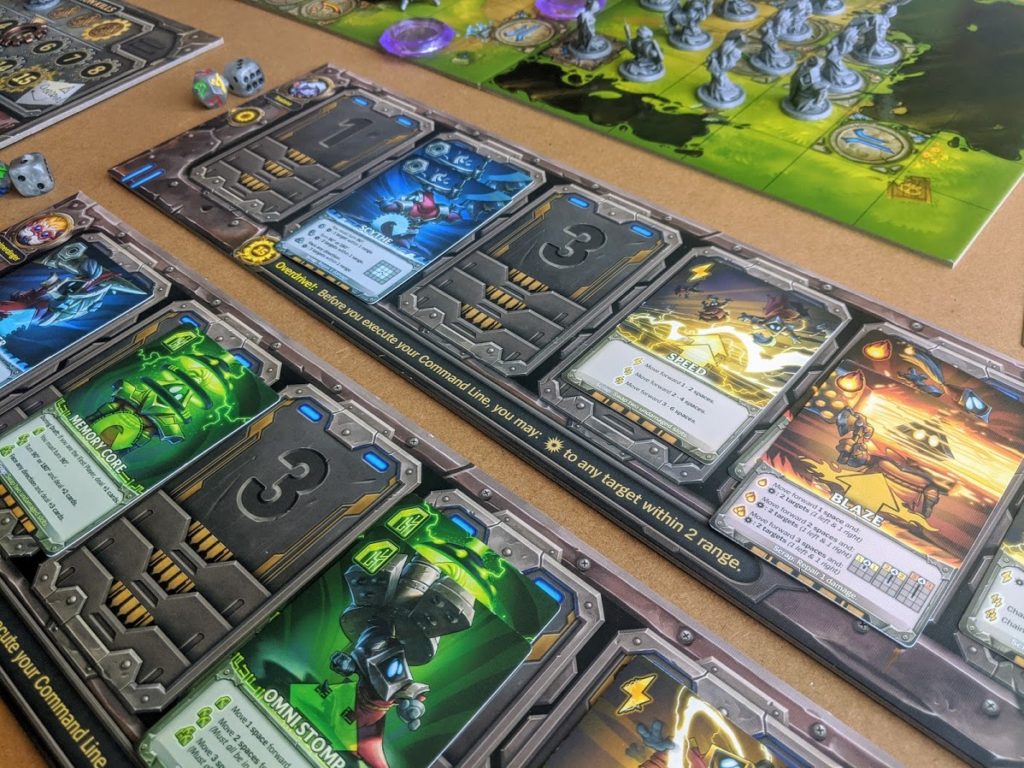
One thing that we really missed is a random scenario generator. It would be great to have that option, MvM is really difficult to put on a table for one quick game session because of how every scenario is a part of a story. And you can’t just start in the middle, that would be silly.
And my final complaint is, I don’t know what I expected from the final envelope, but I was hoping for a secret bonus level, or some more stuff, but there’s none of that, I was a bit disappointed.
The Co-Op
MvM really incorporates the best kind of co-op gameplay. You have to discuss the big picture stuff and need to co-ordinate on a high level very effectively, but it is impossible to keep track of what the other player is doing exactly. I love it when games do that, same thing with Spirit Island.
Also, it’s funny to accidentally mess up each other’s carefully built plans.
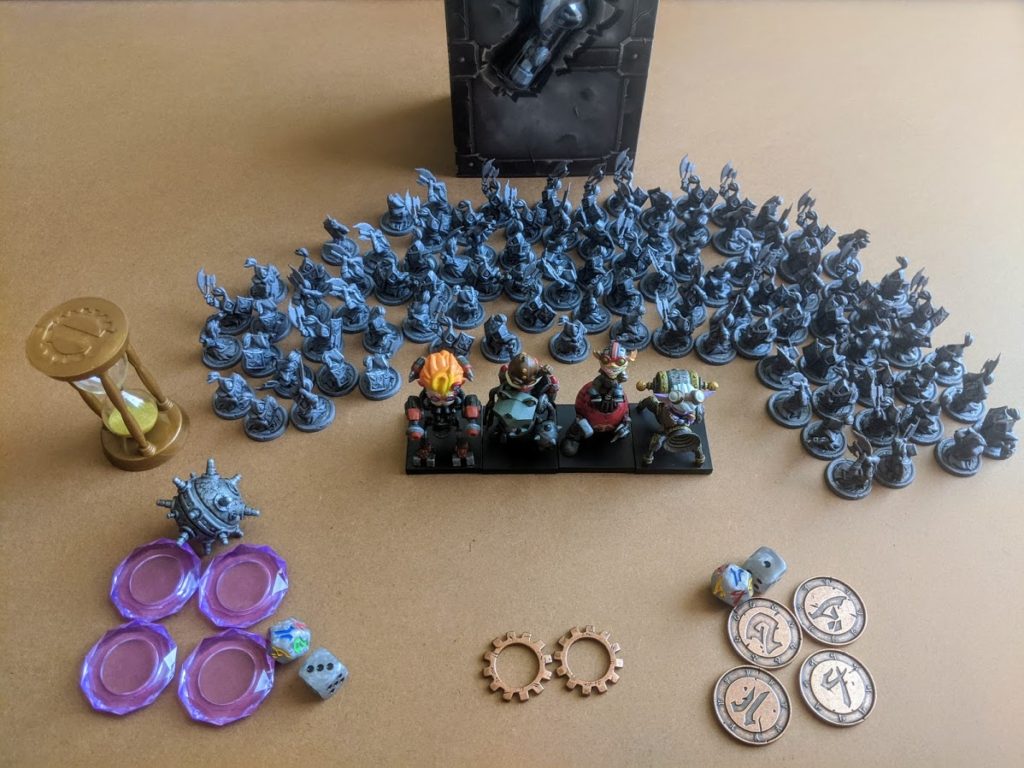
The Recommendation
Yes, there’s really no excuse for not trying this game. It’s totally unique, light and strategic at the same time, and produced at a very high quality.
Info
| Release Year | 2016 |
| Genre | Programming |
| Difficulty | Medium |
| Number of Players | 2 to 4 |
| Length | 1 hour per scenario |
Rating
| Overall | Great |
| Story | Great |
| Co-Operation | Amazing |